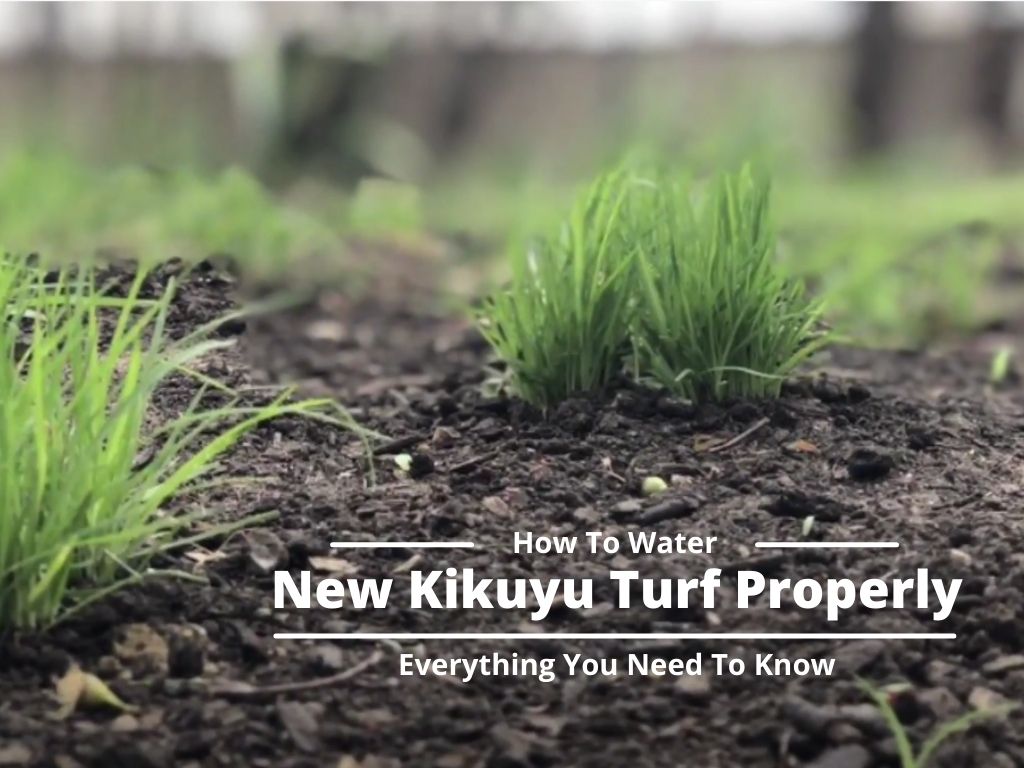
When it comes to new turf, proper lawn care should be practiced, even if you’re growing a low-maintenance grass like kikuyu. Even though kikuyu grass is pretty forgiving, you shouldn’t neglect this type of grass during its establishment phase.
If you’re a landscaping beginner or this is your first time growing kikuyu grass, you may have a long list of questions to start with. So, how do you water and maintain kikuyu turf after it’s newly installed?
Watering kikuyu grass during its first 14 days is crucial, helping the grass to develop a deep and healthy root system. The amount of water needed can vary depending on seasonal changes and local weather conditions, but the best rule of thumb is to keep your new lawn wet at all times.
Most homeowners choose kikuyu grass because it has a lot of added benefits compared to other types of grass. So, if you’ve chosen kikuyu to re-turf your yard, you may even save time and money by keeping up with lawn maintenance yourself. Check out this guide to kikuyu lawn care and find out exactly what to do after installing your new kikuyu turf.
Table of Contents
What is Kikuyu Grass?
Kikuyu is native to the East African highlands and its name is derived from the Kikuyu tribe of Kenya. Back in the 1920s, kikuyu grass was brought to Australia as a pasture grass for cattle and other livestock.
Nowadays, kikuyu grass is growing more and more popular for Aussie lawns because of its wear tolerance. It is known for its rapid lush green growth and drought hardiness. Kikuyu grass also has the ability to spread quickly, thanks to its large prostrate runners.
What Does Kikuyu Grass Look Like?
Kikuyu grass is coarse and light green in colour. The leaves are 4 to 5 mm wide and can grow as large as 25 to 40 mm.
It is easily mistaken for a grass type of similar features, the St. Augustine grass. Some additional distinguishing features of kikuyu grass include:
- leaves are folded in the bud
- ligule is a fringe of hairs
Unsure what that means? The term ‘ligule’ refers to the outgrowth from the sheath of each blade of grass. There are several ligule types used to tell similar grass species apart:
- no auricles
- slightly flattened
- leaf blades are tapering with files of hairs
- hair leaf sheaths
Pros of Kikuyu Grass
Other homeowners choose kikuyu grass because of its dense, bright green soft leaf. These characteristics give the lawn an elegant and uniform appearance, which is what most people would like to see in their garden. This type of grass does not grow as well in saline soils, but is suitable for almost any well-drained and fertile soil. It can adapt widely, but ultimately prefers moist, medium-textured soils.
Kikuyu grass is also known for its amazing regenerative powers. If damaged, it will quickly heal and recover over time, even from a severe frost. During winter, you can apply fertiliser to maintain its vibrant green colour.
One of the best characteristics of kikuyu grass is that it puts down deep roots, which help it thrive in hot weather. The disease susceptibility of this grass is low but if it ever occurs, you can prevent the disease from spreading by use of complete fertiliser to encourage new root development.
Cons of Kikuyu Grass
Like any variety, kikuyu grass also has its downsides. The main complaint people have is its creeping characteristics. It can spread quickly into your garden or onto your path, but it can be controlled by several applications of herbicide.
Kikuyu grass is pest resistant, but in Australia, you may want to watch out for certain insects like lawn grubs, army worms and the African Black beetle. When treating your lawn with pesticides, ensure you follow any safety precautions.
What’s The Best Way To Water New Kikuyu Turf?
There are lots of critical factors to consider when installing new kikuyu turf. The establishment phase needs a lot of attention, as it is during this time the turf develops its root system. Watering several times each day is definitely a requirement since the best approach is to keep the new lawn wet at all times.
After your new turf has been laid, you should water it daily for 2 to 4 weeks. Always check if the soil beneath your grass is damp – it should not dry out or else your lawn will eventually wither and die. Watering new lawns in the morning and late afternoon is the best practice; when the air is cooler the water is less likely to evaporate.
Proper lawn care practice will ensure your new turf results in a successful, beautiful, and inviting lawn. Many of these procedures should be continued once your lawn is established to help it survive and thrive.
When Should I Water New Kikuyu Turf?
New turf should be watered as soon as it’s laid and kept damp continuously. Newly installed kikuyu turf should be watered within 30 minutes of laying, applying enough water to soak the soil deeply (between 7 cm to 10 cm).
Your new lawn should be kept moist for 14 days, watering twice a day for round-the-clock moisture. By the 14th day, the turf should have taken root. At this point, you’ll need to water the lawn regularly for another 7 to 10 days – but only on every second day. Once the roots are established, you’ll only need to water kikuyu grass when there are signs of slight leaf wilting.
How Much Should I Water Kikuyu Turf?
The amount of water required for kikuyu turf depends on the conditions where the lawn was laid, including the current weather. Remember, newly installed turf should be kept moist at all times, but there shouldn’t be excessive puddling or flooding, either. Overwatering your lawn can make your soil soggy or saturated, and this isn’t great for grass either.
If the soil remains soggy or saturated for days or weeks, the grass can actually suffocate and all your hard work maintaining it will go to waste. Overly waterlogged soil can also make your grass more susceptible to diseases. The amount of water and oxygen should be balanced in your lawn to ensure your grass stays healthy.
On the other hand, underwatering your kikuyu turf can also cause problems. Water is absorbed through the roots, so insufficient water will cause the grass to dry out and eventually die without getting established in your yard. With new turf, this additional water is what allows the grass to root into the soil below.
Giving your new turf the right amount of water to actually penetrate down to the roots is important. If you know how deep your roots are, then you can estimate how much water is required, and you should test the soil with a rod or moisture meter to confirm the water is penetrating deeply enough.
How Often Should I Water Kikuyu Turf?
Determining how often you should water your kikuyu turf primarily depends on the weather conditions. New turf requires watering twice a day for the first 14 days. Matured kikuyu turf should be watered every 7 to 10 days, or whenever the lawn shows signs of moisture stress.
During dry hot weather, for new lawns, it’s recommended to water 4 times daily during the first week. Established laws need to be watered 3 times a fortnight for 1 hour per shift.
In moderately warm weather – between 20 C and 30 C – newly installed kikuyu grass requires watering a little less frequently – around 3 times a day for 14 days. In similar weather, the established turf needs watering every 7 to 10 days.
In cooler weather, your grass will need less water, and you may be able to water it only when showing signs of wilting. Of course, in wet weather, the lawn may require no extra watering since it is receiving enough naturally.
If this all sounds very demanding, you’re not alone! You can save yourself some time, money, and water by installing an irrigation sprinkler system. Lawn irrigation set-ups can be programmed to water more often when grass is newly installed, and then adjusted through the various stages as your kikuyu lawn is established.
What’s The Best Fertiliser For New Kikuyu Grass?
Kikuyu grass is a fast, stubborn grower so fertiliser is not essential to make kikuyu grass grow faster. However, the use of fertiliser actually plays a bigger role in keeping your lawn healthy. Using fertiliser can improve the quality of your lawn and helps to get rid of weeds, pests, and diseases.
Kikuyu grass is highly responsive to nitrogen, so a nitrogen-based fertiliser is a great choice for kikuyu grass. This kind of product will be effective for both new and established kikuyu lawns, helping to make the grass greener and warding off any prospective pests at the same time.
To keep your kikuyu grass in tiptop shape, here are some general fertilising tips:
- Summer is the ideal time to fertilise kikuyu grass.
- If you want a healthy and strong kikuyu lawn, apply a slow-release fertiliser twice a year.
- Fertilising during late spring, mid to late summer and late autumn can be used as a rough “schedule” for when to fertilise your lawn.
- Nitrogen-rich fertiliser also helps in colonising bare spots. If using this tactic, only fertilise the spots that need support to avoid extra mowing.
- After applying fertiliser, you should always irrigate your lawn well.
- When using weed-killing herbicides, ensure you get the right advice and choose a suitable product for kikuyu grass.
Can you overwater new turf?
Both overwatering and underwatering can do damage on your newly installed turf. Even though new turf requires plenty of water, you should avoid overwatering to the point of puddling. Overwatering can drown and rot the leaf blades, which is a very expensive mistake to make when installing new turf. If water is pooling on the surface, you may need to reduce the water applied in your next watering session.
How long should you leave newly laid turf before cutting?
You can test if your new turf is ready for cutting by tugging on the grass. If the turf lifts up from the ground, then you should wait and try again after a few more days. But if you end up with a handful of lawn clippings instead, then you can start mowing! It usually takes about 3 weeks for your new lawn to be ready to mow for the first time.
Can I aerate new turf?
Ideally, you should wait at least six months before aerating the new lawn. Aeration helps break up sodding and clumping that can undermine lawn health, so your turf won’t need aerating when first laid. Before you aerate your turf, consider the following questions: Is your turf warm season or cool season grass? Is rain good after aerating lawn? Choosing the best time of year to aerate your lawn will help you get the best results.
Disclaimer:
This article is published for general informational purposes only and does not constitute professional advice. Any action you take upon the information you find on this website is strictly at your own risk. Always ensure you have the right qualifications and certifications to carry out DIY work and never put your safety at risk. Hills Irrigation recommends consulting a professional for all electrical and plumbing work.

Vince is Managing Director of Hills Irrigation and is supported by Lisa in an administrative capacity. Andrew, Isaac and Megan look after the day to day needs of both online and shop customers. As Project Manager, Vince is also responsible for installation projects along with his team. It is his responsibility to work closely with clients to ensure that scope of work is understood and followed.








